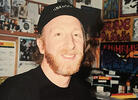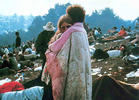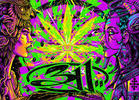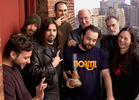
The Bill Graham and the Rock & Roll Revolution exhibit at the New-York Historical Society Museum & Library evokes a flood of memories.
Graham is the famous rock promoter who opened the Fillmore West in San Francisco and the Fillmore East in New York, both havens for the new rock and R&B music of the late '60s and early '70s. Graham went on to produce Rolling Stones tours and Live Aid, but it's his original accomplishments that matter most.
Bill Graham's Early Years

Born in Berlin in 1931, Graham (nee Wulf Grajonca) escaped Nazi Germany thanks to his parents placing him in an orphanage. He arrived in New York in 1938, where he eventually attended my alma mater, De Witt Clinton High School in the Bronx.
Graham moved to San Francisco after attending City College and quickly established himself as a concert promoter, leasing the Fillmore Auditorium where he started booking hot Bay Area groups like the Grateful Dead and Jefferson Airplane in 1966. Two years later, he converted an old Yiddish theater on New York's Second Ave. in the countercultural East Village neighbothood into the Fillmore East.
Remembering the Fillmore East

I was just 15 when I went to my first of three concerts at the Fillmore East. As I've recalled here, after the Woodstock festival in the summer of 1969, which I did not go to, I dedicated myself to seeing all of the Woodstock bands. The first was Santana during their April 10-12, 1970 run at the Fillmore.
Coming down to the East Village from the Bronx, where we lived, was a trip. St. Mark's Place was packed with hippies and dealers hawking every drug. We turned the corner at St. Mark's and Second Ave. and there was the Fillmore East marquee, announcing Santana and It's a Beautuful Day as the night's headliners. The show was early peak Santana, with guitarist Carlos picking his way through a chorus of Latin singers and percussionists. Songs like "Soul Sacrifice," "Evil Ways" and "Jingo," all from their first album, were highlights.
Marijuana smokers had to be discreet at the Fillmore. Security guards would flash you with a light if they saw you toking. The best plan was to get high in the bathrooms, which we did.
My next show was Ten Years After, who dazzled the Woodstrock crowd with the electifying "I'm Coming Home" blues jam. The British rockers, headed by Alvin Lee, put on staggering shows on June 24-25, 1970, with most of the songs from Ssssh and Cricklewood Green.
But my greatest Fillmore show was still to come: Allman Brothers, J. Geils Band and Albert King on June 25, 1971. Graham had decided to shutter the theater and booked this lineup for the final weekend. We scored tickets to the late show, which began at 11:30 pm.

Following sets by King and J. Geils, the Allmans took the stage at 2 am. "J. Geils ripped it," my brother Barry recollects. "The Allmans came on and played a few songs to little reaction from the crowd. Gregg (Allman) said something like, 'It's tough to come out after J. Geils.' Then they kicked it into high gear. We came out in the sunlight and went to breakfast. Even Gregg said in his autobiography it was a singular event. Never happened before. Never to happen again."
Here's how Graham recalls that show:
"They came off stage at Fillmore East at 4 am, but Duane and Gregg wanted to keep playing, so I said they could... After they were done, somebody hit the side door and light started streaming into the house. I looked at my watch and it was five after seven. Duane turned around and looked at me and said, 'Hey Bill, just like leavin' church, huh?'"
After more than seven hours of intense music - including the Allmans' "Whipping Post," "In Memory of Elizabeth Reed" and "Mountain Jam" - we filed out onto Second Ave., squinting at the dawn sunrise. Hungry, we went next door to the Jewish dairy restaurtant Ratner's and had that delicious breakfast.
It remains the greatest individual concert I ever attended.
Epilogue

After the Fillmore went dark, the building would be revived as a club, The Saint, before being converted into apartments. Now the front of the building where the marquee stood is a bank.
Rock fans migrated to the Academy of Music on E. 14 St., to see their favorite bands (I caught the Allmans, Santana and Savoy Brown there), but it wasn't the same. The Fillmore East was where so many young New York music fans had their first live rock & roll experiences, all for the low, low prices of less than $5 to see three bands, often two headliners.
I'm lucky to be old enough to remember the Fillmore East. For those who want to reminisce, or learn, about those days, the Bill Graham exhibit is the perfect place to start. It runs through August 23.






